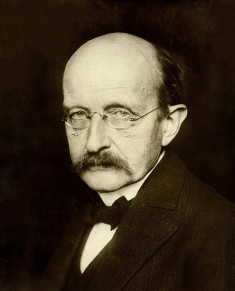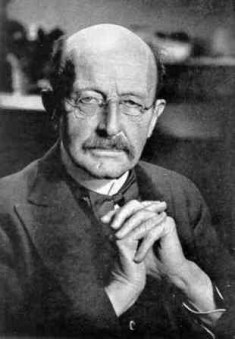| Max Planck | |
|---|---|
 |
|
| Theoretical Physicist | |
| Specialty | Quantum theory |
| Born | Apr. 23, 1858 Kiel, Duchy of Holstein |
| Died | Oct. 4, 1947 (at age 89) Göttingen, Lower Saxony, Germany |
| Nationality | German |
Max Planck was a popular German physicist who is best known for the quantum theory. This theory won him the Nobel Prize in Physics in the year 1918. He made many contributions to theoretical physics and his greatest contribution was when he came up with the quantum theory. This theory changed the whole understanding of atomic and subatomic processes. Together with Albert Einstein who originated the theory of relativity, the two constitute the great fundamental theories of 20th century physics.
Early Life
Planck was born on April 23, 1858, in Kiel, Germany. He was born into a traditional and intellectual family. His grandfather and great-grandfather were all theology professors while his dad was a law professor. Max was the sixth child of the second wife of his dad.
In 1867, Planck’s family moved to Munich and Max joined Maximilians gymnasium school. Here, he met Herman Muller, a mathematician who taught him mechanics, mathematics, and astronomy. With the help of Muller, Max Planck was first able to learn about the principle of energy conservation. At the age of 17, he graduated.
Later Education
Max was also good in music and he even took singing lessons and played the cello, piano, and organ. He also composed operas and songs. However, after a while he found physics more interesting and decided to study it rather than music. In 1874, Max started his studies at the University of Munich. He studied under Professor Philip Jolly and only performed experiments related to his scientific career.
He focused his studies on the diffusion of hydrogen for a while, but he later chose to concentrate on theoretical physics. In 1877, he went to Berlin for one year to study with other famous scientists such as Hermann Helmholtz, who later became a very good friend. In 1877, Max passed his qualifying exams and briefly taught mathematics and physics. In 1880, he presented his habilitation thesis.
Planck’s Career in Science
 After his habilitation thesis, Max Planck became an unpaid lecturer in Munich. He still continued to work on the heat theory. In 1885, he started working at the University of Kiel. After four years, he was offered a position at the University of Berlin. Here, he worked as a professor of theoretical physics.
After his habilitation thesis, Max Planck became an unpaid lecturer in Munich. He still continued to work on the heat theory. In 1885, he started working at the University of Kiel. After four years, he was offered a position at the University of Berlin. Here, he worked as a professor of theoretical physics.
He studied thermodynamics in examining distribution of energy according to wavelength. He combined Wien and Rayleigh formulas. After his studies, he announced he had a new formula called Planck’s Radiation Formula. After two months, he completed his theoretical deduction of his formula. He even gave up classical physics and introducing quanta energy. In 1900, he presented his work involving the quanta of energy at a meeting of Physikalische Gesellschaft in Berlin.
Max’s work on quantum theory was published in Annalen der Physik. Basically, his work is summarized in two books. This theory was the turning point in the history of physics. At first, he was not appreciated, but after a while the evidence of its validity could not be ignored anymore.
Theory of Relativity
In 1905, three papers of Albert Einstein were published in a journal. Max Planck was among the few people who immediately recognized the great significance of the theory of relativity. With his influence, the theory was widely accepted in the country. Planck also contributed to the theory of relativity.
In 1910, Einstein was able to point out the anomalous behavior of specific heat at low temperatures. This was another example of a phenomenon that defies explanation by classical physics. Max was later appointed dean of Berlin University. After getting this position, he was able to call Einstein to Berlin in 1914. The two became very good friends and even played music together.
Black-Body Radiation
In 1894, Planck diverted his attention to black-body radiation. He had been asked by some electronic companies to create maximum light from light bulbs but with minimum energy. In 1899, he proposed his first solution, but the formula was found to be inaccurate. He revised his approach and derived the famous Planck black-body radiation law.
Family and Personal Life
Max Planck married Marie in the year 1887. Together, they had four children. After several happy years, Marie died in July of 1909 from tuberculosis. In 1911, Max married his second wife, Marga. Max got his fifth child in December of that year. During the First World War, his second son was taken prisoner by French in 1914.
His eldest son was killed while his third child died while giving birth. In January, his son Erwin was sentenced to death because of his participation in a failed attempt to assassinate Hitler. He was executed on January 23, 1945.